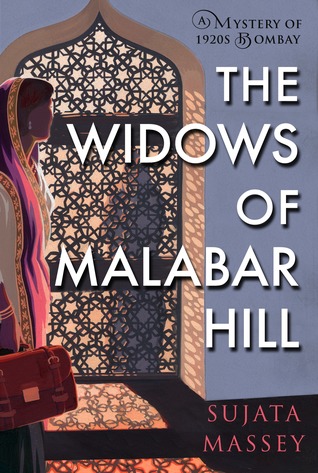The Widows of Malabar Hill, by Sujata Massey
Set in early 20th century Bombay, The Widows of Malabar Hill centers on Perveen Mistry, one of the first female solicitors in India. She has joined her father’s law firm. Though she has a legal education at Oxford, she cannot argue cases in court. Thus she spends most of her time dealing with contracts, wills, etc., while her father represents clients in the courtroom.
The firm has been appointed to execute the will of a wealthy Muslim man. His three widows have all signed paperwork stating that their full inheritance will go to a charity. Perveen is suspicious.
The widows live in seclusion and cannot speak face-to-face with a man, only speaking to their appointed male guardian through a grid work-type window. They have almost no contact with the outside world.
Perveen, as a female, talks to each of the widows to make certain that they understand the legal documents they have signed. And it’s clear that the women don’t have all the facts. Neither does Perveen. As she begins to investigate, a murder occurs in the house. And it looks like the culprit may be one of the household members.
The book flips between the past and present. The present story revolves around the widows and the murder. The past centers on Perveen’s disastrous marriage to a wealthy but unscrupulous young man, her life with her extremely traditional in-laws, and the heartbreak and betrayal that have given her a passion for women’s legal rights.
The author has obviously done her research into the subject matter, and it shows. I learned so much about India in the early 20th century.
What didn’t work for me:
-
The dual timeline wasn’t effective.
The sections are long enough (several chapters each) that I became absorbed in that time period’s storyline. That’s fine. But that made the switch to a different time period jarring. My absorption momentarily broke at those points.
The other problem is that the past storyline (about Perveen’s disastrous marriage), though interesting, had little bearing on the present storyline (Perveen’s murder investigation). I felt like I was reading two different stories. Both were interesting on their own. While I understand the author wanted to show why Perveen’s tragic background fueled her desire for fair treatment of the widows and their children, the past storyline was needlessly drawn out. It could have been reduced to much shorter flashbacks and woven into the present story. I didn’t need to know most of the information from the past.
-
Many of the non-English terms were not defined in the glossary.
It was frustrating to read an unfamiliar Urdu or Hindi or Parsi word, flip to the back, and not find it defined. It broke my absorption in the story.
What worked for me:
-
Perveen as a protagonist.
She’s smart, impulsive, and filled with longing for the wisdom and knowledge that her father has, such as knowing how to deal with the police or knowing the law. I also really liked that she’s loyal and caring. She’s always protective of the widow’s children’s well-being, but she’s also concerned for the child servants. After the murder, she urges the police not to force the children to clean up the bloodied crime scene.
Recently, I’ve read too many “strong” female protagonists who are selfish, cold, and reject all traditional “feminine” qualities just to be independent. But empathy is part of what make us human. Perveen strikes the right balance between being strong and caring, and I appreciate that.
-
The cultural clashes.
There’s the clash between the British rulers (represented by her friend Alice’s family) and their Indian subjects.
There are clashes between the various religions: Muslim versus Hindu, with different marital laws, customs, and ways of wearing a sari.
There are the differing customs even among the particular religions; for example, Perveen and her female family members have never secluded themselves during menstruation but it is customary in her husband’s family.
-
The interesting and horrifying details about the treatment of women in 1920s India.
The marital laws were oppressive. Perveen’s forced seclusion during menstruation (because her mother-in-law fears that she will “contaminate” the rest of the household) is shocking.
-
The dynamics of the polygamous family seem realistic.
The widows are sister-rivals, and though outwardly they live in harmony, tensions and competition run beneath the surface. I’ve read other books with polygamy, and the dynamics here jive with what I’ve previously read.
Overall, I mostly liked the book. I would definitely read other books by this author.
If you enjoyed this novel, you may also enjoy The 19th Wife by David Ebershoff, as it also involves polygamy, a dual timeline plot, and an unsolved murder. It’s more literary in tone and style, though.
Review of The Widows of Malabar Hill was previously published on Goodreads.
This is part of the Year of the Asian reading challenge. Join the fun and sign up on Shut Up, Shealea’s blog.

